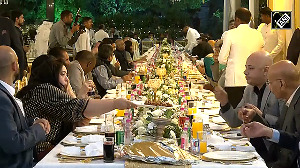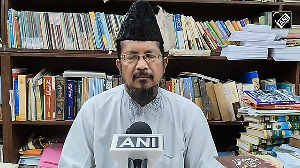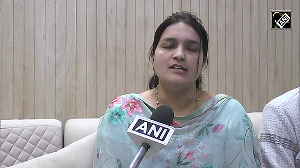'2019 now looks like a real contest.'
'It will not be a repeat of 2014 if the BJP has to deal with erosion of its already low vote share of 31 per cent, and also faces a united Opposition,' says T N Ninan.

The results of 10 Lok Sabha by-elections held in the last eight months make one thing clear: It is not just the coming together of the non-BJP (Bharatiya Janata Party) parties that has reduced the BJP's tally to a solitary seat out of the 10, a sharp contract to its victory in 8 out of the same 10 in the 2014 Lok Sabha elections.
Opposition unity has been a necessary factor, but on its own that would have made little difference to the by-election outcomes.
Defeat for the BJP needed a second development: Significant erosion of the party's vote base.
Equally, the BJP could have won, even with an eroded base, if the Opposition had remained divided.
Each therefore was a necessary but not sufficient condition for the BJP to lose.
It is the combined effect of the two factors that has made the difference.
In 6 of the 10 seats, the BJP in 2014 enjoyed not a plurality but an absolute majority -- more than 50 per cent of the votes cast.
In another two seats, the party's vote share was only marginally short of the halfway mark, having secured 48.7 per cent in Phulpur and 46.3 per cent in Gurdaspur.
Opposition unity in 2014 would have made little or no difference to the results in these and similarly-placed seats, since their combined vote share would have been less than half.
It follows that if the BJP had retained its 2014 voting base today, even the combined Opposition would have made little impact in the by-elections of the last eight months.
Such analysis must be approached with caution.
By-election results tend to go against the party in power, and are unlike general elections in that local issues tend to hold greater sway (like the grievances of sugarcane growers in Kairana).
Often, the government's big guns do not go out to campaign.
Still, the BJP's loss of vote share since 2014 is striking.
In Alwar and Ajmer, both in Rajasthan, the party’s vote share has shrunk by 35 per cent and 20 per cent, respectively; in Gurdaspur by 22 per cent.
The loss of vote share has been relatively small in Gorakhpur (9 per cent), hence its loss to the Samajwadi Party was also by a relatively small margin.
Where the BJP can take some solace is in West Bengal, where in the Uluberia constituency it has effectively displaced the Communists as the principal opposition to the Trinamool Congress.
In 2014, the Communists had garnered two-and-a-half times as many votes as the BJP. Now they are a poor third.
It is also noteworthy that in Kerala's Chengannur assembly constituency, the BJP though coming in third is not all that far behind the Congress in second place.
The Congress, of course, presents a truly sad picture, despite having won 3 of the 10 seats -- Gurdaspur and two in Rajasthan.
Elsewhere, in constituency after constituency where about a million people voted, the Congress vote tally has failed to clear even the 25,000 mark.
Take a look at its numbers in some of the constituencies: 18,858, 19,353 and 23,109.
In Palghar, the party has come in fourth.
The 10 constituencies where by-elections have been held are in states that among them account for 235 Lok Sabha seats, more than 40 per cent of the total.
As samples go, this may not be a decisive indicator.
On the other hand, the results are from 6 different states where the BJP has a strong presence, while in Karnataka the coming together of the Congress and the Janata Dal-Secular could deny the BJP many of the 17 seats it won in 2014.
One should not under-estimate the fighting power of the Modi-Shah duo, but 2019 now looks like a real contest.
It will not be a repeat of 2014 if the BJP has to deal with erosion of its already low vote share of 31 per cent, and also faces a united Opposition.
Note: This analysis excludes the results of the Nagaland and Srinagar by-elections, both won by local parties that don't have a larger national relevance.












 © 2025
© 2025